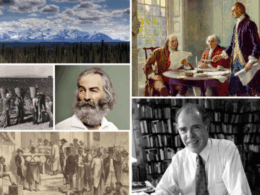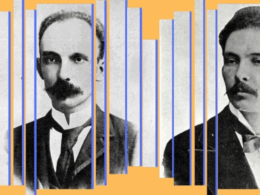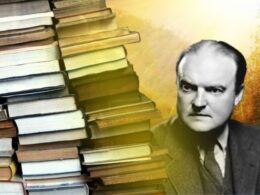By David Denby
Five years ago, I set out to investigate a very practical question: How in the world do you get fifteen-year-olds, many of them immersed in screens, to read seriously? How do you excite them about literature? I chose fifteen-year-olds—tenth-graders—because they are running through a period in their lives when crucial issues of identity (college or military? what kind of work? straight or gay?) claim a lot of their attention. Yet, at fifteen, they can still be reached. Now, no one reading a Library of America blog post could be indifferent to what’s at stake in this straightforward pedagogic issue: Are we going to create three-dimensional men and women—and citizens—in this country? We will drown if we don’t. Getting students to read seriously lies at the heart of establishing judgment, critical thinking, empathy, and a future audience for literature—an active participation of readers and writers in the defining stories we tell one another.
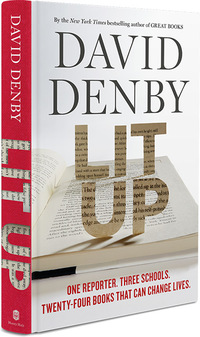
At the moment, no one could be encouraged by the statistics on book-reading among teenagers. Yes, they are reading more words than ever before, but they are reading fragments on screens much of the time—parts of books, articles, texts (endless texts), bits of information from here, there, and nowhere—and not many books, particularly serious books of one sort or another. To answer my question, I “embedded” for an entire academic year in a single tenth-grade English class in a Manhattan public school—the Beacon School—and, later in my reporting, I repeatedly visited an inner-city school in New Haven, Connecticut, and an upper-middle class school in Mamaroneck, New York. I wrote up my observations as a narrative, and Holt published it, in February of this year, as Lit Up.
In the tenth-grade class at the Beacon School, taught by an inspired dynamo named Sean Leon, the students read Hawthorne’s difficult story, “The Minister’s Black Veil.” As they struggled, I couldn’t help wondering, What about The Scarlet Letter? The book, central to the American canon, had become notoriously hard to teach in high school. The Scarlet Letter is passionate, almost anguished, fantastical, shot through with intimations of the supernatural entering everyday life, but for American teenagers it is also stiff, awkward, and distant. As it happened, an eleventh-grade class at Beacon was taking up The Scarlet Letter at the same time as Mr. Leon’s tenth-grade class was reading “The Minister’s Black Veil.” So I had to find out. How do you teach this extraordinary book? What follows is a slightly expanded version of what appears in Lit Up.
At the beginning of her classes, Mary Whittemore, an attractive woman in her late thirties, with light brown hair and gray-green eyes, pushed the desks out to the far walls and lined up the abandoned chairs in rows. The class had become an auditorium. Suddenly, from the corner behind her, a student emerged from a supply closet. She was holding a bedraggled baby doll, and she was wearing on her chest a large A. The other students giggled and sighed. An instant of suspense: Would the A fall off? No, it was made of felt, and it had an adhesive back. She climbed onto a chair on a raised platform in front of the class, and everyone began hissing and jeering.
Thus the first scene of Hawthorne’s novel, in which Hester Prynne, the book’s magnificent heroine, emerges from a “beetle-browed and gloomy” jail and stands on a scaffold before a good part of seventeenth-century Boston. In her arms, she holds her illegitimate baby, Pearl. After this opening bit of classroom theater, Miss Whittemore handed out pages of script to different students who played the the principal characters—the handsome young minister, Arthur Dimmesdale, Hester’s former lover; the decrepit elderly doctor, Roger Chillingworth, her cuckolded and coldly enraged husband; the town officials and clergymen, the harpies and ordinary citizens. She chose still other students to read the narration. The script was the students’ first introduction to the novel. Reading aloud, they stumbled over words like “contumely,” and they laughed at the intentional period formality of Hawthorne’s prose—the “hithers” and “haths” were a problem.
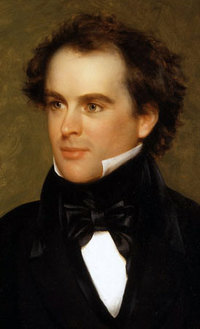
D. H. Lawrence, in Studies in Classic American Literature, teased Hawthorne as “a blue-eyed darling” who nevertheless “knew many disagreeable things.” Among the disagreeable things that Hawthorne knew: prurience, social cruelty, sadism masquerading as concern, moral weakness disguising itself as sanctity. Hester is an outcast, branded for her adultery, yet she has not, in her own eyes, done anything wrong; Dimmesdale, in his own eyes, has, and he suffers terribly from agitation, physical weakness, despair—all the symptoms of a man in psychological torment. But his sin is not so much lust as hypocrisy. When he stands before the community as a minister, he feels himself an imposter, and his torment is only increased when Chillingworth, who keeps his identity hidden, moves in with him under the guise of helping him and sticks the knife in and twists it. Nasty solicitude is perhaps the most disagreeable thing that Hawthorne knew.
Miss Whittemore’s students were an ethnically mixed group, white black, Latino, and Asian—a New York cohort from upper-middle-class, middle-class, and poor families (about a quarter of the school’s students fell below the poverty line). In a country as diverse as America, there are no “typical” schools, but this school was at least representative, and the students were baffled by the moral logic of the story. They had trouble understanding a society suffused with the presence of God, and still greater difficulty accepting extreme punishments dealt out by a godly people. One girl, exasperated, burst out: “I don’t get it. If she’s married, and she’s got a baby, what is the problem?” There speaks the twenty-first century! Her scorn produced a ripple of amusement. Listening to them, I thought to myself, the students were living in that part of America which had been emboldened by the loosening of sexual morals in the sixties. As John Updike once put it, a Freudian view had prevailed: Sexual health required pleasure, large doses of it. The students judged Hester by modern standards, and by those standards, in which sexual pleasure was a right for women as well as men, she was certainly not innocent, but she was not terribly guilty, either. In general, the students initially felt that the emotions of the story were overwrought in relation to what was actually at stake. Why was an entire community obsessed with an adulterous woman? Hawthorne’s own view, of course, was infinitely complicated and finally unknowable. He was a novelist, not a moralist; or not simply a moralist.
As she worked her way through the novel with her students (they read it home as well as in class), Mary Whittemore was calm, encouraging, friendly—her face mild, her eyes flashing when a student said something especially interesting. Yet she was extremely persistent, with hints of an underlying fire beneath the warmth and equanimity. The students responded to her, especially in those moments when she cast away mildness. For four weeks, she alternated an increasingly detailed discussion of character, atmosphere, and motive with additional performances in the reading theater. After a while, the idiom became more familiar, the difficulty of the prose easier to handle. When Miss Whittemore caught a student reading Dimmesdale weakly, she asked, “What does that mean? What did you just say? Do you know what you just did, Dimmesdale?”
“Let me think,” the reader said shyly. A few minutes later, when the conversation came back to him he said, “I just made a lot of excuses and contradicted myself,” which caught Dimmesdale’s confusion; the reader had fallen into the character without quite realizing it. So did the others. A tall, pale, intellectual boy, dry and earnest, with a bony nose and parchment voice, read Dimmesdale a few times and then seemed more like Dimmesdale every time he made a comment. A blustering boy lowered his voice to insinuation as Chillingworth. A girl who spoke a great deal, her words normally a thicket of “likes” and “sort ofs,” read Hester’s refusal to relinquish her child— “God gave her into my keeping. I will not give her up!” —with passionate anger, and, after that, her classroom comments became leaner, more to the point, less self-conscious. She was the first woman to give herself to what she was reading. The others followed. Some of the women began to speak angrily of what Hester had to put up with. Hester embroiders her A, flaunting it, and the girl who was so derisive about Hester’s situation earlier said, “Her spirit isn’t being beaten down with it. She’s fighting it.” Whatever the students’ resistance to the novel, Hawthorne’s defining strength cleared away their adolescent vagueness.
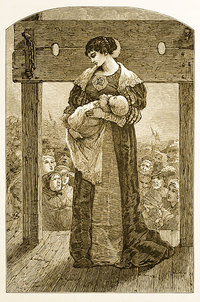
As the weeks went on, the students admitted that they were surprised by the power of the fable. Hawthorne suspended the three adults and Hester’s daughter, wicked little Pearl—a child associated with nature, amoral and irrepressible—in a physically vague but psychologically dense thicket of fear, guilt, pride, and vengeance. At first, the students thought Chillingworth might be sincere, even helpful in his advice to Dimmesdale. A worldly, knowledgeable man, plausible, sensitive to the nuances of personality—Chillingworth’s ruthless subtlety did not fit into their moral universe. Understanding what he was up to was an introduction, for many of them, into the nature of perversity, a stage in their moral education and their perception of character. The girls in the class, initially baffled by Hester’s situation, warmed to her power, her indifference to contempt. Hester becomes a repentant Christian woman, yet there’s something brewing in the fervency of her pride. “She was patient—a martyr, indeed—but she forebore to pray for her enemies; lest, in spite of her forgiving aspirations, the words of the blessing should stubbornly twist themselves into a curse.”
Mary Whittemore not only got the students to embody the characters as much as possible, she made them see the fable as shaped around certain choices, conditions, changes in character. She kept shifting the classroom routine, hitting the students with different exercises, challenges, contexts—rearranging the desks, for instance, for debates over Chillingworth’s character. In class, they turned toward one another and explicitly disagreed. Should Dimmesdale publicly confess his affair with Hester, as Chillingworth insists? The confession would end his public usefulness as a minister. On one occasion, Whitmore assigned a single page to each student, randomly chosen in class, and asked them to write a commentary on that page. Even if they had wanted to, they couldn’t have used an online study aide (the bane of all English teachers) to outsmart her. She kept the apparatus of reading constantly in motion, so the students could never settle or allow the book to fall away from them. She made the book possess them, so that, eventually, they would possess the book.
All along, they had been quizzed on the reading, and near the end of the unit there was a full-length test, followed by a final assignment: They wrote papers extending the narrative, in the voice of one or another of the characters. The tall, bony boy whose Dimmesdale was so effective wrote, of Hester, “Her hair was a beautiful black, like the night’s sky, that flowed down her face like rain, like the flow of water down a stream”—a lover of women wrapped in parchment and uncertain grammar. The girls were bolder, more in the spirit of Hester. One girl wrote about a young woman going back and forth between two lovers—Hester unleashed. Another wrote a utopian fantasy of old New England under the domination of women, with some of the gender roles reversed—Dimmesdale is a woman married to Chillingworth, and Mr. Hester Prynne is a man, with whom Dimmesdale has an affair. That sent my mind spinning.
In the final class on The Scarlet Letter, Mary Whittemore showed up wearing a twenty-dollar black Cher wig and holding a baby doll in her arms—the same baby doll that a student had held earlier. It was a return to the scaffold, where Hester had faced the jeering students. Miss Whittemore sat on a high stool. “The teacher Mary asked me to talk to you,” she said quietly. “She asked me to answer your questions for your test tomorrow. I will answer any of your questions about my behavior.” The students settled down and peppered her. They were with her, longing on her behalf for the happiness which, at the same time, they accepted she would never have. They all agreed, for instance, that Hester Prynne could not run away with Arthur Dimmesdale even if he had the strength to take her off. In the end, the moral complexities of The Scarlet Letter made sense to them. Taught aggressively and flexibly, with humor and dramatic power, Hawthorne’s difficult book still lives in high school.
Of course, this is only one class, and in one school. Surely Miss Whittemore’s way of teaching The Scarlet Letter cannot claim to be the only way. You might say it was a moral and thematic rather than a literary reading. An approach that emphasized structure, language, and metaphor would be a more difficult to pull off, but, perhaps, in the end, more satisfying. But remember that so many American teens are grudging readers. They must begin somewhere. These students had done a good first reading of a difficult American classic.
There is no royal road to heaven. But just as certainly, parts of what Miss Whittemore did could be highly useful—even galvanizing—with different students, living in different cities. They are as diverse as the forest, American students, but, to adapt the language of seventeenth-century Boston for a second, their souls all need to be saved.

David Denby is a staff writer and former film critic for The New Yorker, and his reviews and essays have appeared in The New Republic, The Atlantic, and New York magazine, among other outlets. In addition to Lit Up, he is also the author of _Great Books, an account of returning to college and reading the Western classics during the curriculum wars; American Sucker, Snark, and Do the Movies Have a Future? He lives in New York City with his wife, writer Susan Rieger.
